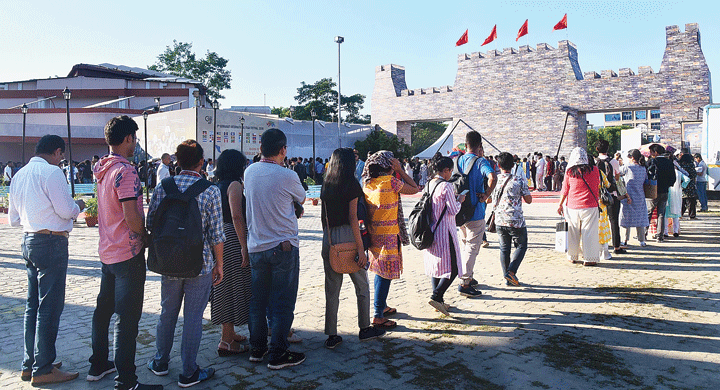
A queue to enter the film festival venue at Srimanta Sankaradeva Kalakshetra UB Photos
Filmmakers and critics taking part in an open forum at the third edition of Guwahati International Film Festival (GIFF) here on Saturday said festivals help to promote film as an art form and should also travel to smaller towns so that a film-watching culture can be developed.
National award-winning filmmaker Manju Bora said, “I must thank the state government for initiating a festival like this and it is great to watch college and university students coming to watch world cinema. I hope at least 10 per cent of these students will think and realise about the cinema and that will make a huge difference.”
Speaking on the need to create a film-watching culture, Bora, who recently won the national award for her film In The Land of Poison Women, said small festivals should be organised in smaller towns to give more people the opportunity of watching films. “Then we can hope to popularise the film as an art form,” she said.
Bora’s film, made in Pangchenpa dialect, is based on a village in Arunachal Pradesh near the border of China-administered Tibet. It is about a blind belief in the Pangchenpa community that women have poison in their nails and when they serve food to men, the latter die immediately or slowly.
But the modern educated generation is trying to eradicate this belief from their society.
The film was screened at the festival on Saturday.
Internationally-acclaimed film critic, curator and festival adviser Premendra Mazumder, who moderated the discussion, said film is already a very popular medium but it needs to be popularised as an art form.
Mazumder dwelt on the initiatives taken by the West Bengal and Kerala governments to popularise and promote the cinema as an art.
“In this regard, Guwahati is the latest edition,” he said.
National award-winning film critic and author Apurba Sharma advocated that a healthy atmosphere and audience need to be created before popularising the cinema as an art form.
The festival will screen more than 100 films from around 65 countries at four halls — three at Srimanta Sankaradeva Kalakshetra and one at Jyoti Chitraban.











